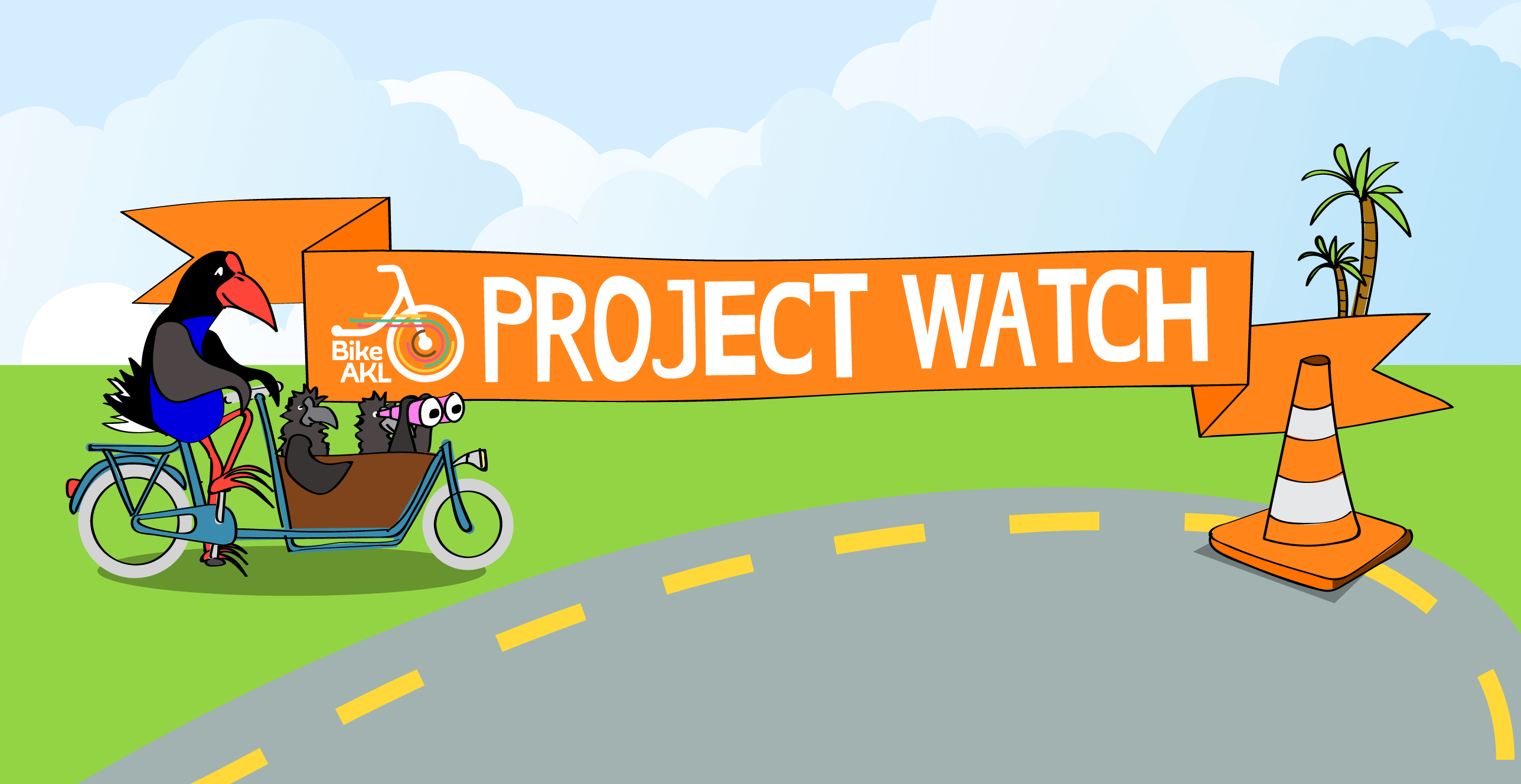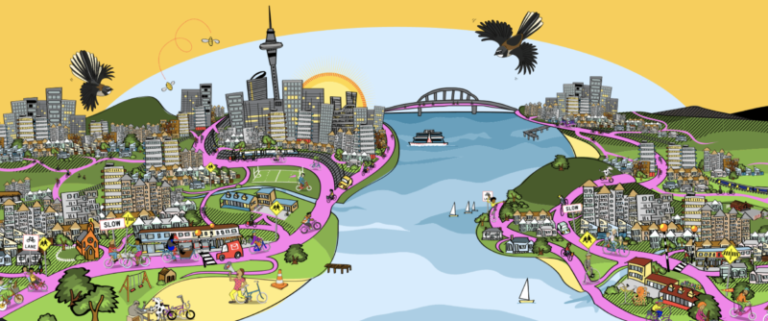It’s time for another edition of Project Watch! This bumper spring edition covers the last two months – during which Auckland had its wettest August ever, hence not a lot of progress on the (soggy) ground. It’s worth the wait, though. Read on for updates of what’s getting under way…
First things first: have you voted yet?
We can sit here and just watch the sometimes agonisingly slow roll-out of safe routes for cycling… or we can take action. Voting in the local elections is an easy and essential way you can make a huge difference.
This election will be a critical one, with transport is one of the key issues. Will we finally get safer speeds on city streets? Will Auckland Transport’s commitment to Vision Zero be active and strong, or window-dressing? And of course, will bikeways be built “at scale and at pace”, as promised… or delayed again and again?
Choosing political leaders who’ll be visionary and staunch on these matters is one of the most important things you can do.
Need help choosing? Visit our election info page, where we highlight candidates who’ve pledge to fight for better investment and faster action for walking and cycling in the next three years. The page also has links to great scorecards by other organisations.
Then vote – and soon! There’s only a few days left. Your vote needs to be in the mail by Tuesday 8 October – but if you didn’t manage that, drop it off at a Council library or service centre until noon on Saturday!
And even if you’ve lost or not received your voting papers, you can cast a special vote up to noon on Saturday at a council service centre, library, or one-stop shop.
Vote for a better Auckland, now!
Where are the Urban Cycleway Programme projects?
This has been the big question since around 2016, when it became clear the majority of projects in the original 2015-2018 programme wouldn’t be finished by 2018. Since then, a few have been completed, and others finally started (K’ Road!), but many still seem to be always just over the horizon.
After recent rumours about further delays, we met with AT senior management – and were told that the rumours were just that, and that AT remains committed to completing the remaining UCP projects by 2021. They clarified they were not guaranteeing no more delays ever again; but committed to acting strongly to keep to the timeframes of last year’s “restart” of the programme.
We’ve also had design meetings with AT about the Tamaki Drive Cycleway (AT is still in discussion with Ports of Auckland about the design between The Strand and the ports entry, but it seems to be progressing well, and should not hold up the main causeway works) and reviewed the Victoria Street West plans. We will also meet AT about other projects on the list in coming weeks.
So here are the starting times for construction that Auckland Transport provided to us a week ago, and explicitly allowed us to share, which gives some confidence:
- 4th Quarter 2019 – Northcote Safe Routes (bridge clip-ons over SH1)
- 4th Quarter 2019 – New Lynn to Avondale is imminent, i.e. October
- 1st Quarter 2020 – Tamaki Drive (The Strand to Ngapipi)
- 1st Quarter 2020 – Victoria Street West (Beaumont Street to Nelson Street)
- 1st/2nd Quarter 2020 – Herne Bay traffic calming scheme
- 2nd Quarter 2020 – Links to Glen Innes Town Centre and Station
A few other projects (including Glen Innes to Tamaki Drive – see our newest blog here) have rough starting times, but most are still either too far out or not confirmed enough for us to repeat them here yet.
The point is that by the first few months of 2020, a lot of these projects should have finally broken ground. Touch wood – we’ve been disappointed before – but as advocates, we always look forward and upwards!
Karangahape Road: works in progress
The works are now finally well underway, with no major hitches so far, knock on wood. When completed in 2020/21, K Road will not only get new protected bike lanes, but also massively more space for pedestrians. The things you can do when you finally act on what previously was only shown in pretty pictures!
Speaking of pictures – the new bike lanes and footpaths are not really visible yet. But the amount of extra space for people is already visible in images like this:
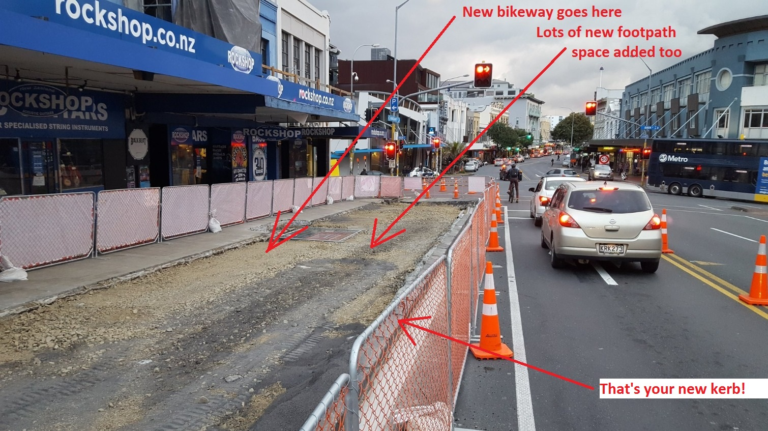
Don’t let the construction get in the way of visiting K’ Road, where all shops are still open. Even with only 2% of all shoppers actually parking on K’ Road (as surveyed in extensive studies by AT), there’s no question that construction works like this are hard on small retailers. So do go and shop, or visit one of the cafes!
Bike Auckland and our various friends and allies have been putting some of our own money where our mouths are, with recent well-attended Bike Breakfasts on K’ Road.
(Bike Breakfast is our monthly mobile feast, and is a great way to drop in and chat on what we’re up to and what’s happening in the bike space. Keep an ear out for the location of our November catch-up.)
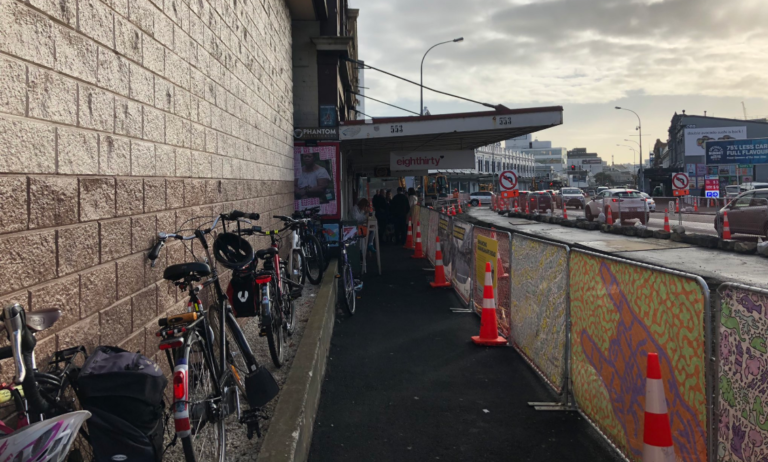
Left hooked at Nelson Street
Concerns have been raised for a long time that drivers are ignoring the “no left turn” sign on Nelson Street, turning into Cook Street illegally across the bikeway. There have been a lot of close calls, and at least one rider has been hospitalised. It’s not good.
Read our blog here about how we’re asking Auckland Transport to improve this danger spot, and what’s been looked at so far.
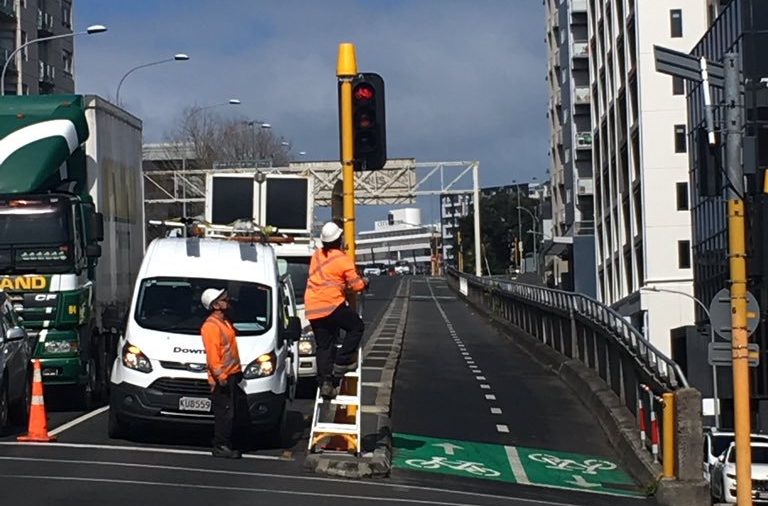
Royal Oak Roundabout
Royal Oak is a perfect illustration of the plight of Auckland’s “Bike Bermuda Triangle”. A maelstrom of vehicles, with nary a bikeway anywhere in sight. And, if the current Auckland Transport project here is a sign of things to come, that won’t change any time soon – despite some big-ticket projects signalled for Manukau Road in the more distant future.
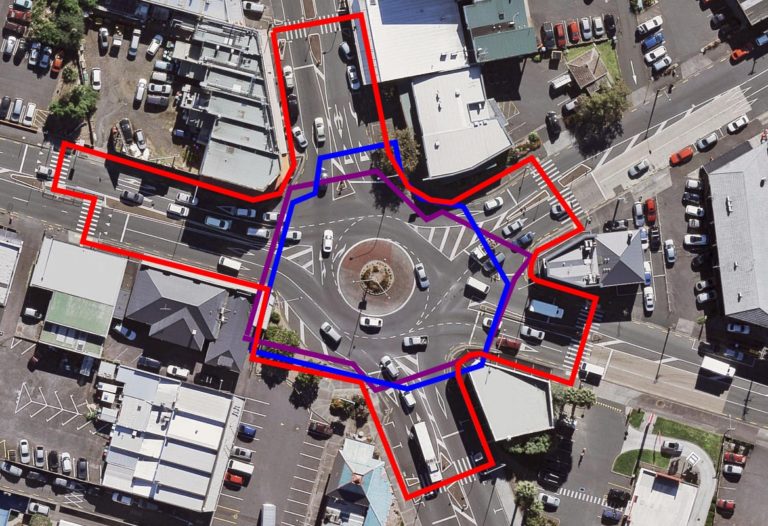
Consultation has now closed, but read our take on AT’s “good-but-not-good-enough” attempts to make this intersection safer for people on foot, while leaving the truly necessary change in the “too hard” basket…
Cox’s Bay – a small local path, or a local path that’s too small?
Also in “are we doing this right?”, Auckland Council is currently consulting to extend an existing shared path as part of the Waitemata Greenways plan scheme.
Only 240m long, the proposal improves an existing path in Cox’s Bay Reserve with Wharf Road by removing some stairs and upgrading a small bridge.
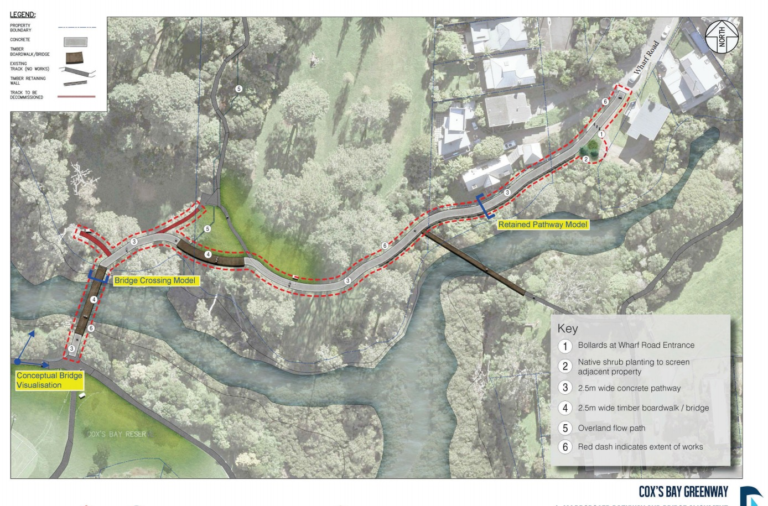
The changes will absolutely benefit locals walking and cycling through the area, especially given the path is currently barely more than a meter wide.
However – the design only widens the path to 2.5m, which is substandard for a shared path. We can understand the constraints here, on a slope with drainage issues; the extra retaining needed for a 3m or wider path would be costly. Even so, this project highlights the risk of creating “bikeways” that risk creating or reinforcing direct conflict between riders and pedestrians on shared paths.
Still, overall we feel the project is worth your support here. Just say that you’d love more width wherever possible, even if it can’t be managed along the whole length. Council have indicated that the 2.5m are not an absolutely done deal yet…
Our pop-up protection campaign
Bike network going too slow? Trying to please everyone by adding urban design, stormwater, and landscaping improvements, as well as new footpaths and safety features? Finding that opponents of bikeways then still turn around and blame you for the extra costs involved in doing everything? Maybe you need some pop-up protection!
We’ve been wrestling with these issues forever, but with a climate emergency and a road safety emergency, we need to be faster and more nimble in tackling them. Even if all those Urban Cycleways finally happen, they cover only a tiny part of the city. So what about the rest? How can we go faster, and further, for safer cycling for all?
Some weeks ago, we gave AT the list you helped create – of bike lanes around Auckland where “pop up“ protection can be added without rebuilding the road, by using items from the tactical toolbox like in the images below.


The good news is that our list has met with some keen people in AT, who are now working through our proposal and making a case to start implementing some of the most feasible routes… and in much shorter timeframes than current bikeway projects. It’s hoped the first few routes could be implemented in less than a year, which is… pretty fast for Auckland. They’re also ranking the other projects so while the big urban cycleway programme and its successors rumble on, some things can go faster.
Yes, some extra money will need to be found first (although much, much less than for the big projects we have all been waiting for). But initiatives like this make us hope that we can reinvigorate AT’s appetite for faster, nimbler projects again.
Creating more of these “climate-protecting lanes” is also one of the key actions we recommended for the Auckland Climate Action Framework. Because when the current annual target is only 10 km of cycleways, nothing would say “at scale and at pace” like delivering 50km of these lanes a year.
Unclogging the bottleneck on the Northwestern Cycleway
After a couple of years of persistent advocacy by Bike Auckland and Newton Primary School, Auckland Transport has finally got into gear. The result: a separated footpath, alongside the cycleway.
Be sure to read our blog post, and submit on the consultation in as little as three words: “Yes! Soon!! More!!!”
If all goes well, construction could start as early as the first or second quarter of 2020.
By the way, we hear concerns from people in other parts of Auckland about this being “yet another inner isthmus bike project”. We do feel you, particularly when many areas don’t have any bikeways at all – and we can understand the frustration.
Though this is a pedestrian project addressing the downsides of rising ridership as much as a bike project. So, assuming it goes well, we hope it’ll be instrumental in changing AT and NZTA’s thinking about shared paths.
Because really, why get brand new shared paths built in your hood, only to have to fight for them to be separated a decade later? Knock on wood, we will now see more and more protected bike lanes or separated walk/cycle paths instead. In that regard, this project should lift standards across all of Auckland, and chip away at the shared path default of old.
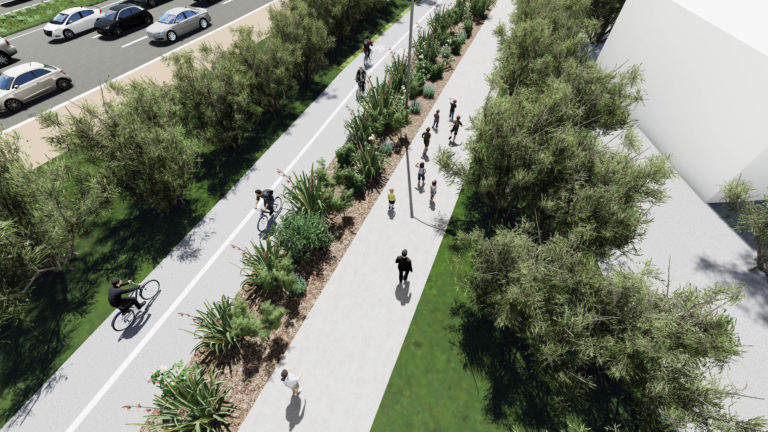
Northwestern Cycleway reaching Westgate
And now for something at the bigger end of the project scale, on the same route – the extension of the Northwestern Cycleway even further north-westwards.
This is an NZTA project, which runs from Lincoln Road to Westgate (as part of the motorway widening; not exactly climate action, that one). It will add a further 3km to the path, from where the cycleway currently ends at Lincoln Rd, all the way to the Yellow Bridge at Massey/Westgate.
Along the way, new side accesses will be opened at Huruhuru Road, Triangle Road (near Lincoln Park Ave) and Royal Road. The project also passes right outside Royal Road Primary School, adds a new shared path and Copenhagen bike lanes (!) on the Royal Road overbridge, and allows you to cycle almost all the way to the shops and cinemas of the Westgate Centre.
The new cycleway extension should be open before Christmas. Here are some progress photos from our friends at Bike Henderson:

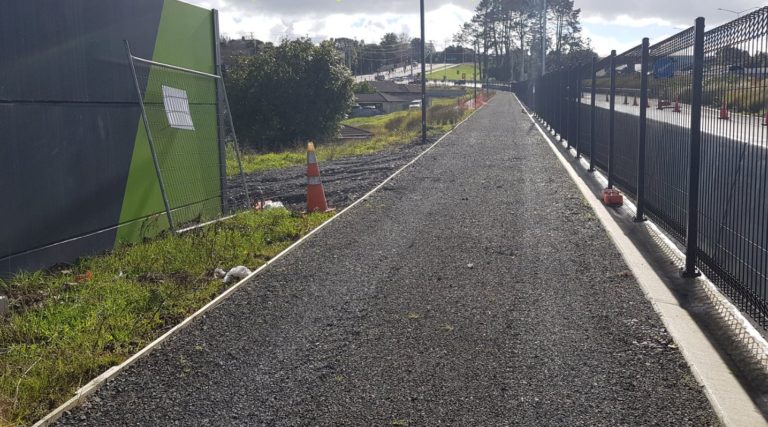

New Old Mangere Bridge starting end of the year
It has been confirmed that NZTA is planning to start construction on the replacement of the old Mangere Bridge end of this year.

This key walking and biking route over the Manukau was affected earlier in 2018 when the old bridge had to be closed for structural safety reasons.
The construction contract has now been awarded, and our chair Barbara attended the dawn blessing ceremony for the works. So we’re confident that you’ll see changes happening soon, the first being the demolition of the old bridge.
During construction, you’ll still be able to walk and cycle across the Manukau Harbour, using the underslung path on the big bridge.
Request yourself some bike parking!
AT has finally launched an easy tool so you can request where you want to see more bike parking in Auckland. You can drop a pin on the map here.

Two big new levers in the toolbox for safer streets
As bike advocates constantly dealing with missed opportunities and big promises, we know that words are both cheap and enormously important. So it was with a classic combo of shrugs and jubilant fist-pumps (at the same time!) that we greeted two recent announcements from AT: the release of the long-delayed and long-awaited Transport Design Manual, and the adoption of Vision Zero as official policy for our city.
The Transport Design Manual (TDM)
The Transport Design Manual is effectively the guidebook on how to design streets – proper streets, for all of us.
When you consider how dramatically thinking about road safety and walking and cycling has changed in just the last decade, you shudder to think that until now, AT has been working with design guidelines that were woefully out of date despite “only” being released in the early 2010s.
The TDM changes that – and it really brings the goods! Ranging from clear, unambiguous guidance for when protected bike lanes are needed – and with nary a word on shared paths at all! – to beautifully rendered graphics of how to build a protected intersection, to explaining “home zones” and safer-speed road designs, these pages hold a clear and strong vision for the kind of transport future Auckland needs.
After a draft / interim period of six months, this guide will become the default design standard for our roads and streets.

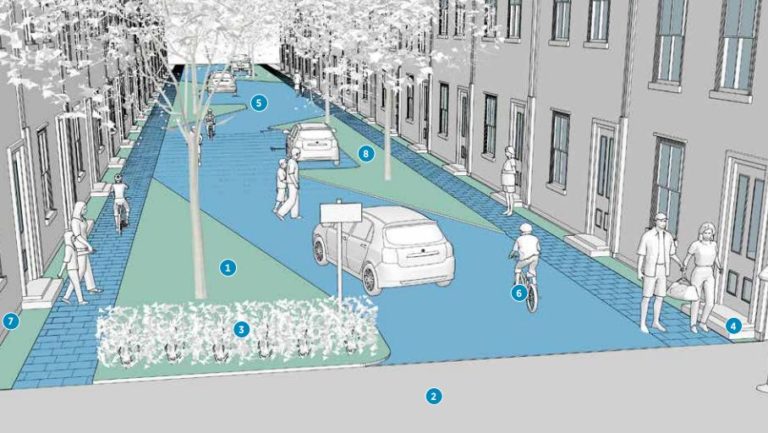
Some have expressed concern about how well AT will follow its own guidelines – particularly when budgets are always under pressure, and some of the new moves will impact on vehicle flows. And we’d be fibbing if we said we didn’t share those worries.
However, AT has clarified that the TDM won’t just apply to new streets and total overhauls of existing streets. Once it’s out of draft, it will apply everywhere. Does this mean that every time AT touches a street or an intersection, we’ll get best-practice design? Clearly not – but the new guidelines will still be crucial, we feel.
Previously, things like bike lanes and safe crossings were effectively “add-ons”. With the TDM in force, if they aren’t included by default, AT will have to justify the omission. On some projects, this may turn out to be an academic difference, especially in the initial years of the guideline use. But reversing the burden of proof in favour of better and safer designs is a fundamental transformation.
Vision Zero
The Vision Zero announcement by Auckland Council and Auckland Transport likewise sets an admirable goal – no deaths or serious injuries on Auckland’s roads by 2050.
That very statement contains both the goal, and the key challenges in achieving it.
It is amazing that Auckland now finally, officially, agrees that the lives of human beings must not be traded off against other benefits like a few seconds less travel delay at an intersection. All this is thanks to advocacy from various groups – and fearless political leaders such as Pippa Coom – on a long quest to achieving this official declaration.
But at the same time, a target 30 years in the future hardly galvanises a bureaucracy into significant action. And while the words are now official, “business as usual” procedures grind on. Budgets also have not (yet?) shifted towards, for example, building more bikeways (Herald Premium link). And a fear of public pushback and people emailing their local Councillors will likely continue to dog the design decisions that are necessary – in fact, are now ethically mandatory – as part of Vision Zero.
So, like the TDM, Vision Zero is an essential leap ahead on the long path to a better city, rather than an overnight fix. Like the Climate Action Framework, both are absolutely vital levers we will use to advocate, argue and mandate for change.
For real change, at the scale and pace we need, we’ll need all of us working as one. And on that closing note, we ask again – have you voted?
Project Watch represents hours of work, meetings, and expert feedback from our team of volunteers. If you like what you read and want to support our work on your behalf, we always welcome donations to keep the air in our tires!

